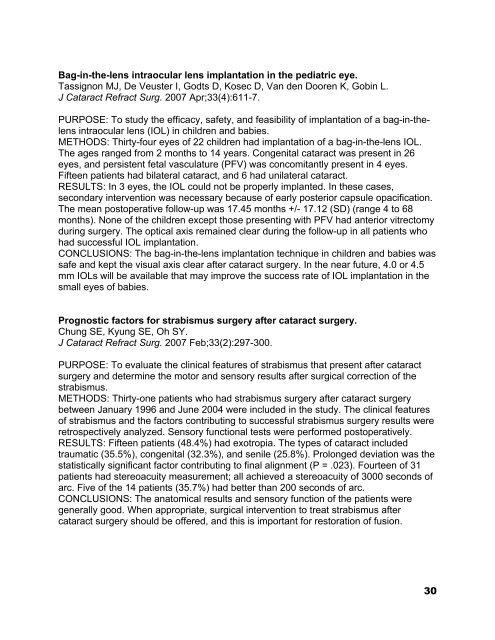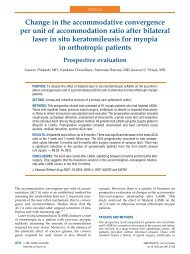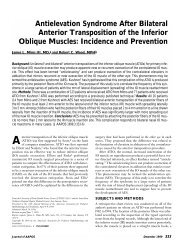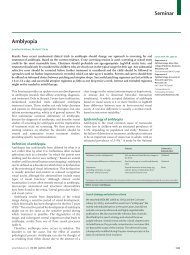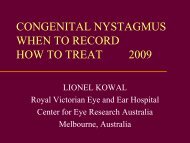What's new AAPOS 2008 - The Private Eye Clinic
What's new AAPOS 2008 - The Private Eye Clinic
What's new AAPOS 2008 - The Private Eye Clinic
Create successful ePaper yourself
Turn your PDF publications into a flip-book with our unique Google optimized e-Paper software.
Bag-in-the-lens intraocular lens implantation in the pediatric eye.<br />
Tassignon MJ, De Veuster I, Godts D, Kosec D, Van den Dooren K, Gobin L.<br />
J Cataract Refract Surg. 2007 Apr;33(4):611-7.<br />
PURPOSE: To study the efficacy, safety, and feasibility of implantation of a bag-in-thelens<br />
intraocular lens (IOL) in children and babies.<br />
METHODS: Thirty-four eyes of 22 children had implantation of a bag-in-the-lens IOL.<br />
<strong>The</strong> ages ranged from 2 months to 14 years. Congenital cataract was present in 26<br />
eyes, and persistent fetal vasculature (PFV) was concomitantly present in 4 eyes.<br />
Fifteen patients had bilateral cataract, and 6 had unilateral cataract.<br />
RESULTS: In 3 eyes, the IOL could not be properly implanted. In these cases,<br />
secondary intervention was necessary because of early posterior capsule opacification.<br />
<strong>The</strong> mean postoperative follow-up was 17.45 months +/- 17.12 (SD) (range 4 to 68<br />
months). None of the children except those presenting with PFV had anterior vitrectomy<br />
during surgery. <strong>The</strong> optical axis remained clear during the follow-up in all patients who<br />
had successful IOL implantation.<br />
CONCLUSIONS: <strong>The</strong> bag-in-the-lens implantation technique in children and babies was<br />
safe and kept the visual axis clear after cataract surgery. In the near future, 4.0 or 4.5<br />
mm IOLs will be available that may improve the success rate of IOL implantation in the<br />
small eyes of babies.<br />
Prognostic factors for strabismus surgery after cataract surgery.<br />
Chung SE, Kyung SE, Oh SY.<br />
J Cataract Refract Surg. 2007 Feb;33(2):297-300.<br />
PURPOSE: To evaluate the clinical features of strabismus that present after cataract<br />
surgery and determine the motor and sensory results after surgical correction of the<br />
strabismus.<br />
METHODS: Thirty-one patients who had strabismus surgery after cataract surgery<br />
between January 1996 and June 2004 were included in the study. <strong>The</strong> clinical features<br />
of strabismus and the factors contributing to successful strabismus surgery results were<br />
retrospectively analyzed. Sensory functional tests were performed postoperatively.<br />
RESULTS: Fifteen patients (48.4%) had exotropia. <strong>The</strong> types of cataract included<br />
traumatic (35.5%), congenital (32.3%), and senile (25.8%). Prolonged deviation was the<br />
statistically significant factor contributing to final alignment (P = .023). Fourteen of 31<br />
patients had stereoacuity measurement; all achieved a stereoacuity of 3000 seconds of<br />
arc. Five of the 14 patients (35.7%) had better than 200 seconds of arc.<br />
CONCLUSIONS: <strong>The</strong> anatomical results and sensory function of the patients were<br />
generally good. When appropriate, surgical intervention to treat strabismus after<br />
cataract surgery should be offered, and this is important for restoration of fusion.<br />
30


